Exploring the Benefits of Studying in Australia: Literature Review
VerifiedAdded on 2022/10/19
|6
|1571
|14
Literature Review
AI Summary
This literature review explores the reasons why Australia is a highly sought-after destination for international students. It highlights Australia's position as a top international study destination, with a diverse student community and numerous world-class universities known for their high-quality teaching and academic staff. The review emphasizes the wide array of courses and programs available, the country's commitment to innovation and research, and the relatively affordable cost of education compared to other popular destinations. Furthermore, it discusses the opportunities for part-time work, scholarships, and financial aid available to international students, as well as the high employability rates of Australian graduates. The review also mentions the popular fields of study, the adaptability of the Australian curriculum, and the overall advantages the Australian higher education system offers to students seeking a globally recognized degree and a successful career.
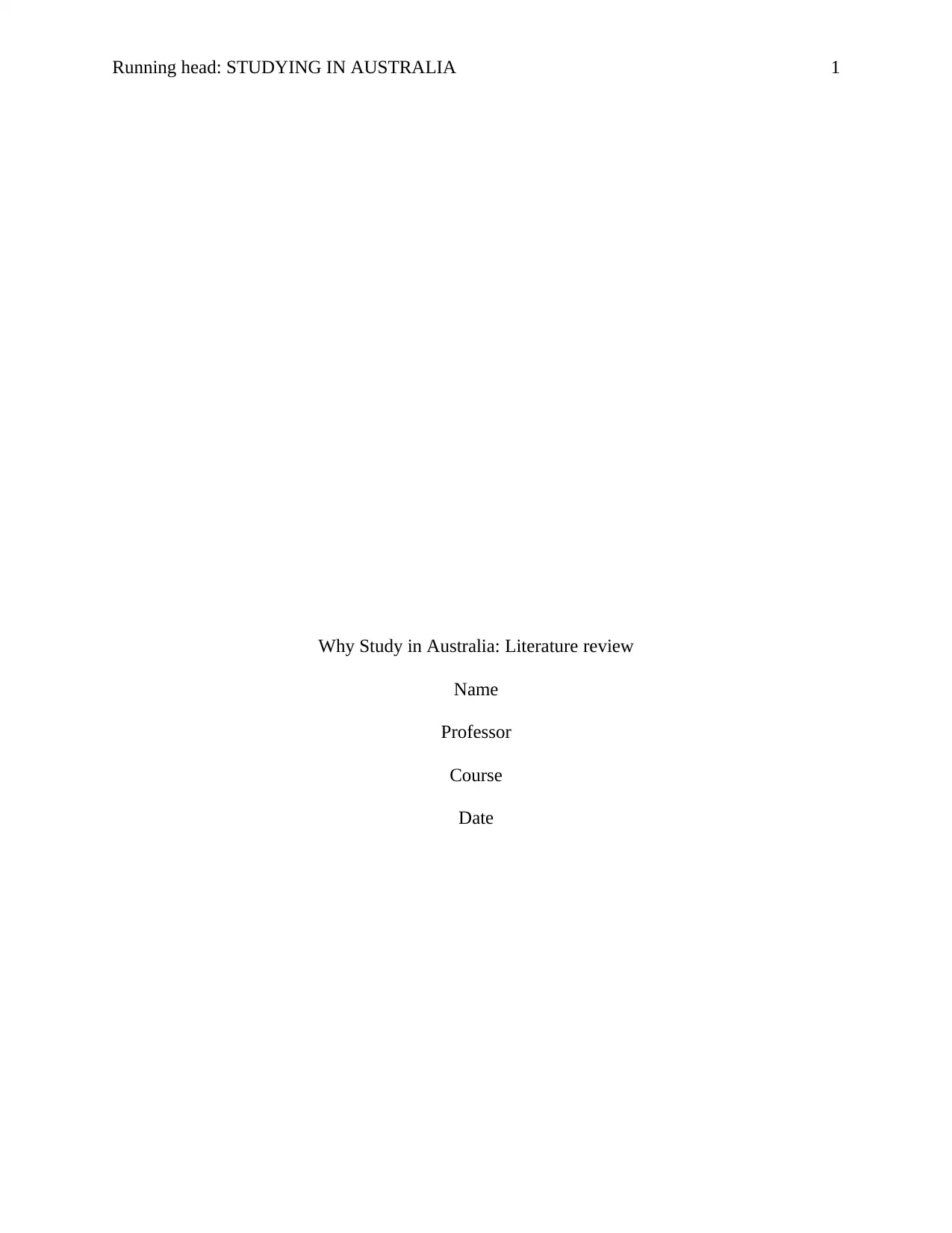
Running head: STUDYING IN AUSTRALIA 1
Why Study in Australia: Literature review
Name
Professor
Course
Date
Why Study in Australia: Literature review
Name
Professor
Course
Date
Paraphrase This Document
Need a fresh take? Get an instant paraphrase of this document with our AI Paraphraser
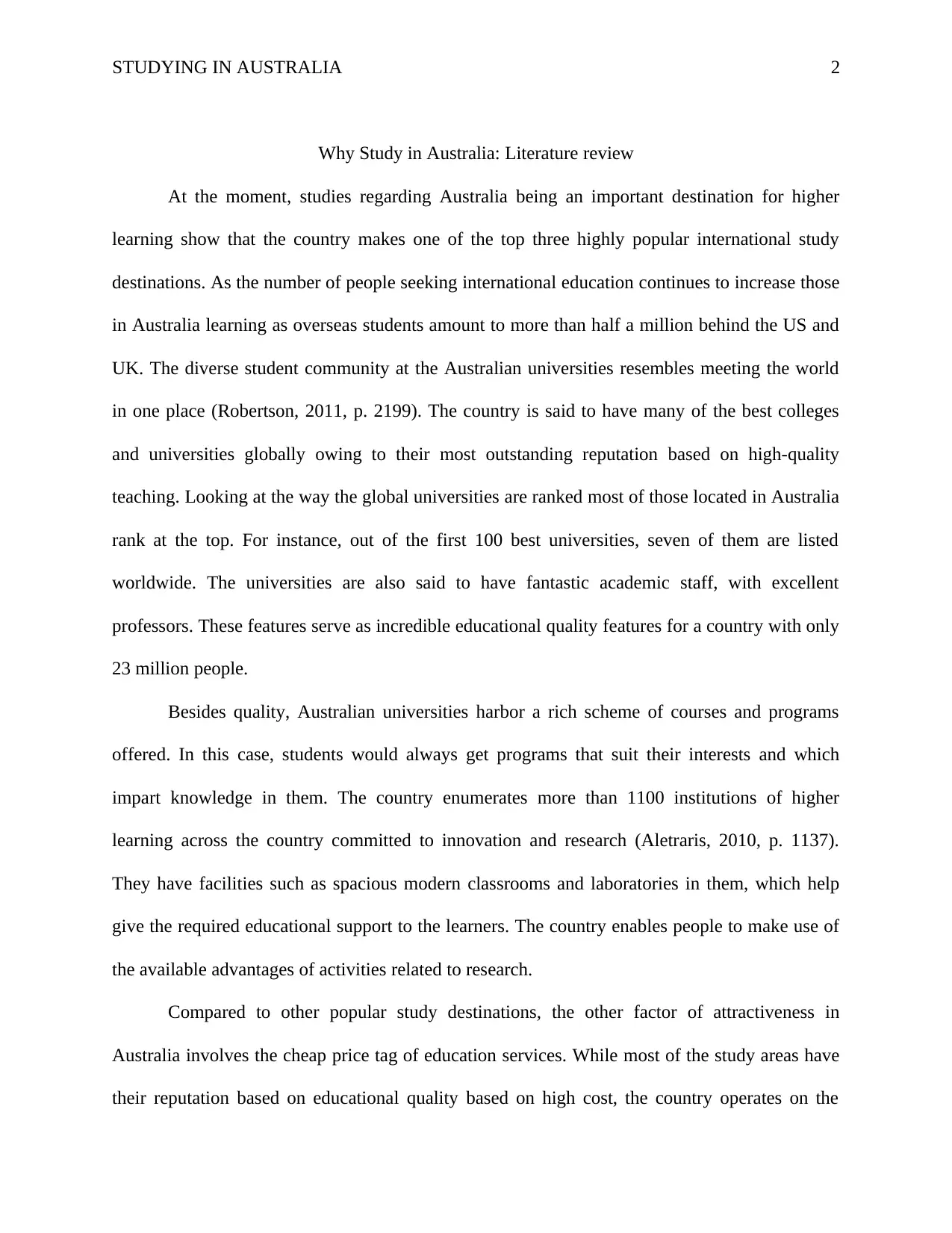
STUDYING IN AUSTRALIA 2
Why Study in Australia: Literature review
At the moment, studies regarding Australia being an important destination for higher
learning show that the country makes one of the top three highly popular international study
destinations. As the number of people seeking international education continues to increase those
in Australia learning as overseas students amount to more than half a million behind the US and
UK. The diverse student community at the Australian universities resembles meeting the world
in one place (Robertson, 2011, p. 2199). The country is said to have many of the best colleges
and universities globally owing to their most outstanding reputation based on high-quality
teaching. Looking at the way the global universities are ranked most of those located in Australia
rank at the top. For instance, out of the first 100 best universities, seven of them are listed
worldwide. The universities are also said to have fantastic academic staff, with excellent
professors. These features serve as incredible educational quality features for a country with only
23 million people.
Besides quality, Australian universities harbor a rich scheme of courses and programs
offered. In this case, students would always get programs that suit their interests and which
impart knowledge in them. The country enumerates more than 1100 institutions of higher
learning across the country committed to innovation and research (Aletraris, 2010, p. 1137).
They have facilities such as spacious modern classrooms and laboratories in them, which help
give the required educational support to the learners. The country enables people to make use of
the available advantages of activities related to research.
Compared to other popular study destinations, the other factor of attractiveness in
Australia involves the cheap price tag of education services. While most of the study areas have
their reputation based on educational quality based on high cost, the country operates on the
Why Study in Australia: Literature review
At the moment, studies regarding Australia being an important destination for higher
learning show that the country makes one of the top three highly popular international study
destinations. As the number of people seeking international education continues to increase those
in Australia learning as overseas students amount to more than half a million behind the US and
UK. The diverse student community at the Australian universities resembles meeting the world
in one place (Robertson, 2011, p. 2199). The country is said to have many of the best colleges
and universities globally owing to their most outstanding reputation based on high-quality
teaching. Looking at the way the global universities are ranked most of those located in Australia
rank at the top. For instance, out of the first 100 best universities, seven of them are listed
worldwide. The universities are also said to have fantastic academic staff, with excellent
professors. These features serve as incredible educational quality features for a country with only
23 million people.
Besides quality, Australian universities harbor a rich scheme of courses and programs
offered. In this case, students would always get programs that suit their interests and which
impart knowledge in them. The country enumerates more than 1100 institutions of higher
learning across the country committed to innovation and research (Aletraris, 2010, p. 1137).
They have facilities such as spacious modern classrooms and laboratories in them, which help
give the required educational support to the learners. The country enables people to make use of
the available advantages of activities related to research.
Compared to other popular study destinations, the other factor of attractiveness in
Australia involves the cheap price tag of education services. While most of the study areas have
their reputation based on educational quality based on high cost, the country operates on the
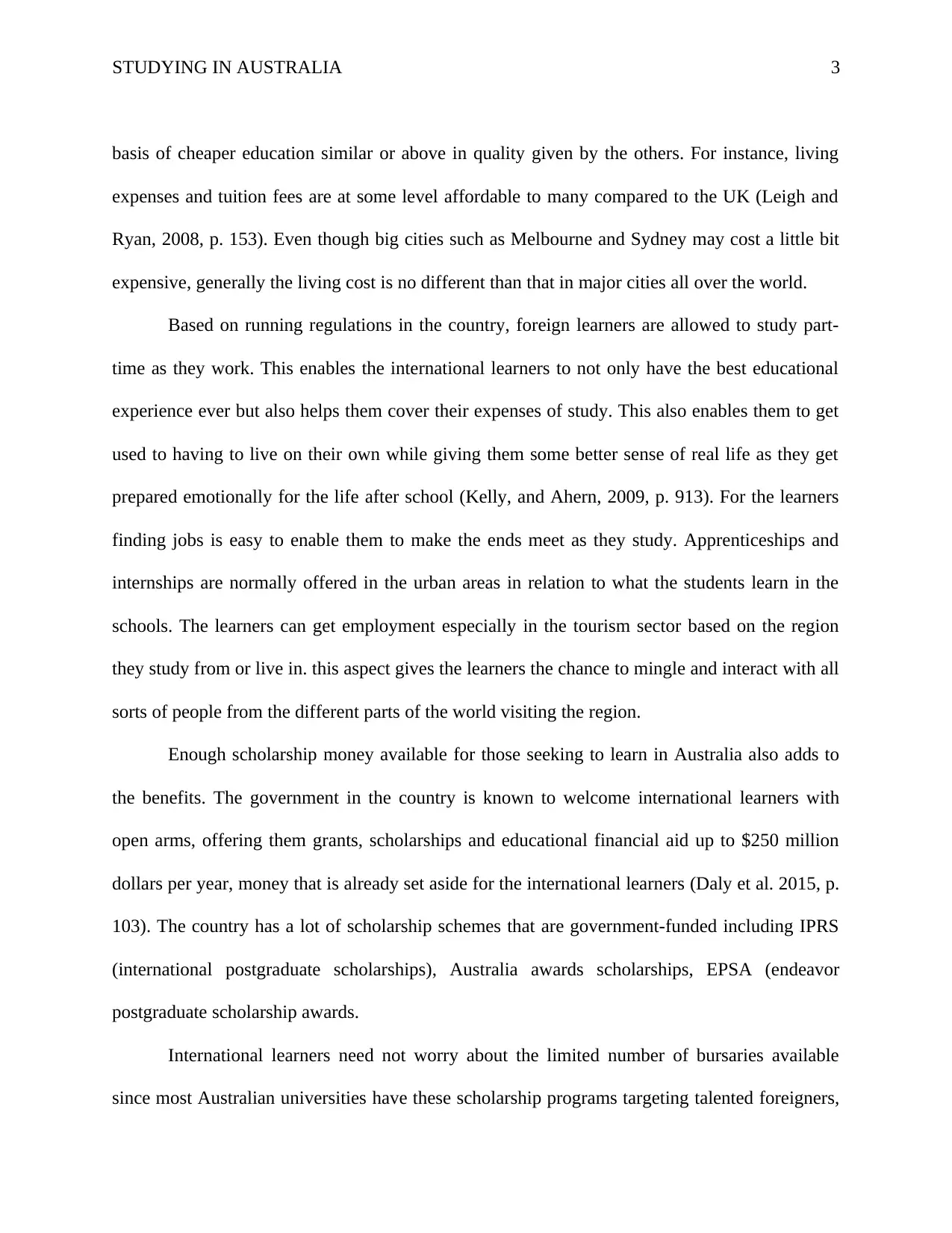
STUDYING IN AUSTRALIA 3
basis of cheaper education similar or above in quality given by the others. For instance, living
expenses and tuition fees are at some level affordable to many compared to the UK (Leigh and
Ryan, 2008, p. 153). Even though big cities such as Melbourne and Sydney may cost a little bit
expensive, generally the living cost is no different than that in major cities all over the world.
Based on running regulations in the country, foreign learners are allowed to study part-
time as they work. This enables the international learners to not only have the best educational
experience ever but also helps them cover their expenses of study. This also enables them to get
used to having to live on their own while giving them some better sense of real life as they get
prepared emotionally for the life after school (Kelly, and Ahern, 2009, p. 913). For the learners
finding jobs is easy to enable them to make the ends meet as they study. Apprenticeships and
internships are normally offered in the urban areas in relation to what the students learn in the
schools. The learners can get employment especially in the tourism sector based on the region
they study from or live in. this aspect gives the learners the chance to mingle and interact with all
sorts of people from the different parts of the world visiting the region.
Enough scholarship money available for those seeking to learn in Australia also adds to
the benefits. The government in the country is known to welcome international learners with
open arms, offering them grants, scholarships and educational financial aid up to $250 million
dollars per year, money that is already set aside for the international learners (Daly et al. 2015, p.
103). The country has a lot of scholarship schemes that are government-funded including IPRS
(international postgraduate scholarships), Australia awards scholarships, EPSA (endeavor
postgraduate scholarship awards.
International learners need not worry about the limited number of bursaries available
since most Australian universities have these scholarship programs targeting talented foreigners,
basis of cheaper education similar or above in quality given by the others. For instance, living
expenses and tuition fees are at some level affordable to many compared to the UK (Leigh and
Ryan, 2008, p. 153). Even though big cities such as Melbourne and Sydney may cost a little bit
expensive, generally the living cost is no different than that in major cities all over the world.
Based on running regulations in the country, foreign learners are allowed to study part-
time as they work. This enables the international learners to not only have the best educational
experience ever but also helps them cover their expenses of study. This also enables them to get
used to having to live on their own while giving them some better sense of real life as they get
prepared emotionally for the life after school (Kelly, and Ahern, 2009, p. 913). For the learners
finding jobs is easy to enable them to make the ends meet as they study. Apprenticeships and
internships are normally offered in the urban areas in relation to what the students learn in the
schools. The learners can get employment especially in the tourism sector based on the region
they study from or live in. this aspect gives the learners the chance to mingle and interact with all
sorts of people from the different parts of the world visiting the region.
Enough scholarship money available for those seeking to learn in Australia also adds to
the benefits. The government in the country is known to welcome international learners with
open arms, offering them grants, scholarships and educational financial aid up to $250 million
dollars per year, money that is already set aside for the international learners (Daly et al. 2015, p.
103). The country has a lot of scholarship schemes that are government-funded including IPRS
(international postgraduate scholarships), Australia awards scholarships, EPSA (endeavor
postgraduate scholarship awards.
International learners need not worry about the limited number of bursaries available
since most Australian universities have these scholarship programs targeting talented foreigners,
⊘ This is a preview!⊘
Do you want full access?
Subscribe today to unlock all pages.

Trusted by 1+ million students worldwide
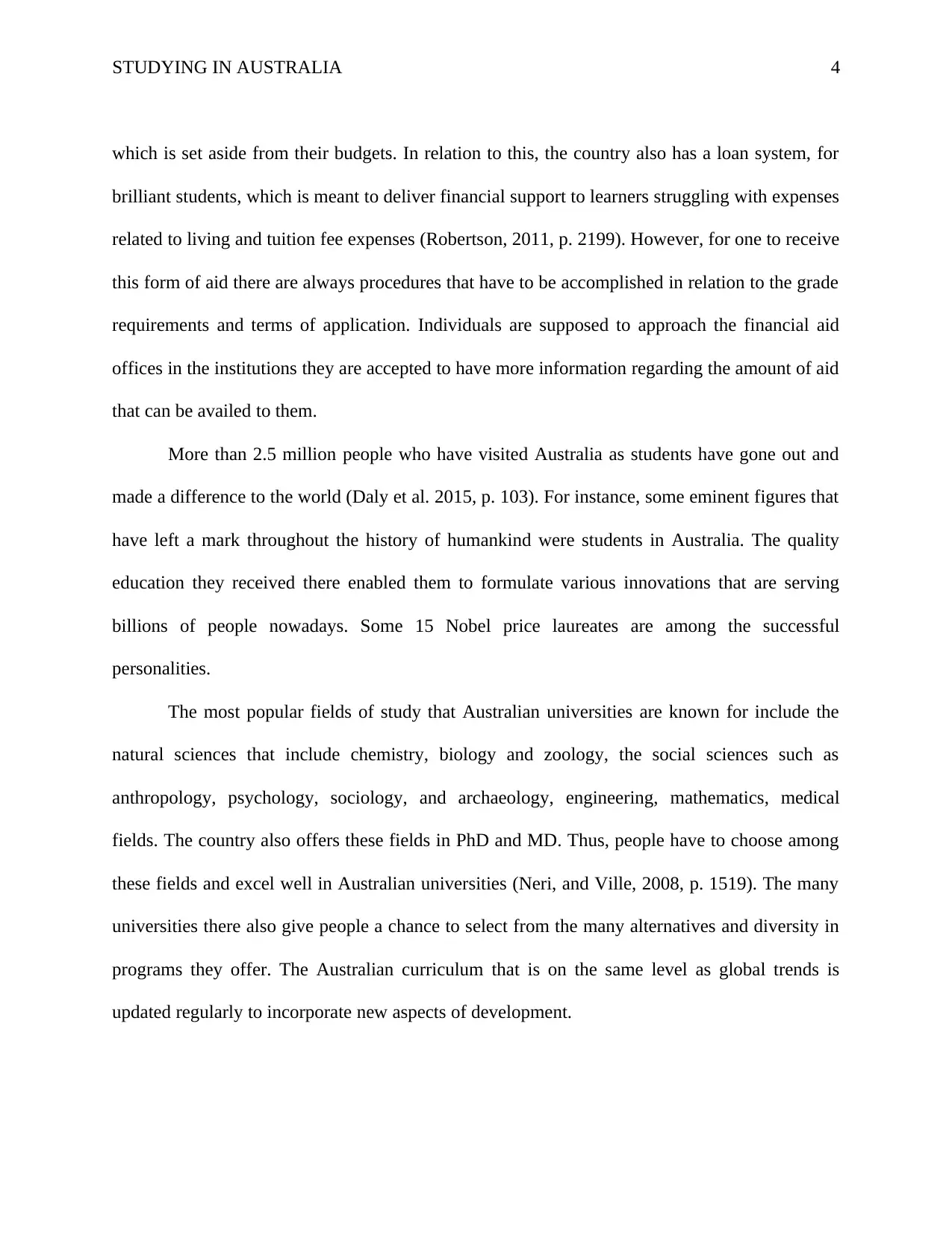
STUDYING IN AUSTRALIA 4
which is set aside from their budgets. In relation to this, the country also has a loan system, for
brilliant students, which is meant to deliver financial support to learners struggling with expenses
related to living and tuition fee expenses (Robertson, 2011, p. 2199). However, for one to receive
this form of aid there are always procedures that have to be accomplished in relation to the grade
requirements and terms of application. Individuals are supposed to approach the financial aid
offices in the institutions they are accepted to have more information regarding the amount of aid
that can be availed to them.
More than 2.5 million people who have visited Australia as students have gone out and
made a difference to the world (Daly et al. 2015, p. 103). For instance, some eminent figures that
have left a mark throughout the history of humankind were students in Australia. The quality
education they received there enabled them to formulate various innovations that are serving
billions of people nowadays. Some 15 Nobel price laureates are among the successful
personalities.
The most popular fields of study that Australian universities are known for include the
natural sciences that include chemistry, biology and zoology, the social sciences such as
anthropology, psychology, sociology, and archaeology, engineering, mathematics, medical
fields. The country also offers these fields in PhD and MD. Thus, people have to choose among
these fields and excel well in Australian universities (Neri, and Ville, 2008, p. 1519). The many
universities there also give people a chance to select from the many alternatives and diversity in
programs they offer. The Australian curriculum that is on the same level as global trends is
updated regularly to incorporate new aspects of development.
which is set aside from their budgets. In relation to this, the country also has a loan system, for
brilliant students, which is meant to deliver financial support to learners struggling with expenses
related to living and tuition fee expenses (Robertson, 2011, p. 2199). However, for one to receive
this form of aid there are always procedures that have to be accomplished in relation to the grade
requirements and terms of application. Individuals are supposed to approach the financial aid
offices in the institutions they are accepted to have more information regarding the amount of aid
that can be availed to them.
More than 2.5 million people who have visited Australia as students have gone out and
made a difference to the world (Daly et al. 2015, p. 103). For instance, some eminent figures that
have left a mark throughout the history of humankind were students in Australia. The quality
education they received there enabled them to formulate various innovations that are serving
billions of people nowadays. Some 15 Nobel price laureates are among the successful
personalities.
The most popular fields of study that Australian universities are known for include the
natural sciences that include chemistry, biology and zoology, the social sciences such as
anthropology, psychology, sociology, and archaeology, engineering, mathematics, medical
fields. The country also offers these fields in PhD and MD. Thus, people have to choose among
these fields and excel well in Australian universities (Neri, and Ville, 2008, p. 1519). The many
universities there also give people a chance to select from the many alternatives and diversity in
programs they offer. The Australian curriculum that is on the same level as global trends is
updated regularly to incorporate new aspects of development.
Paraphrase This Document
Need a fresh take? Get an instant paraphrase of this document with our AI Paraphraser
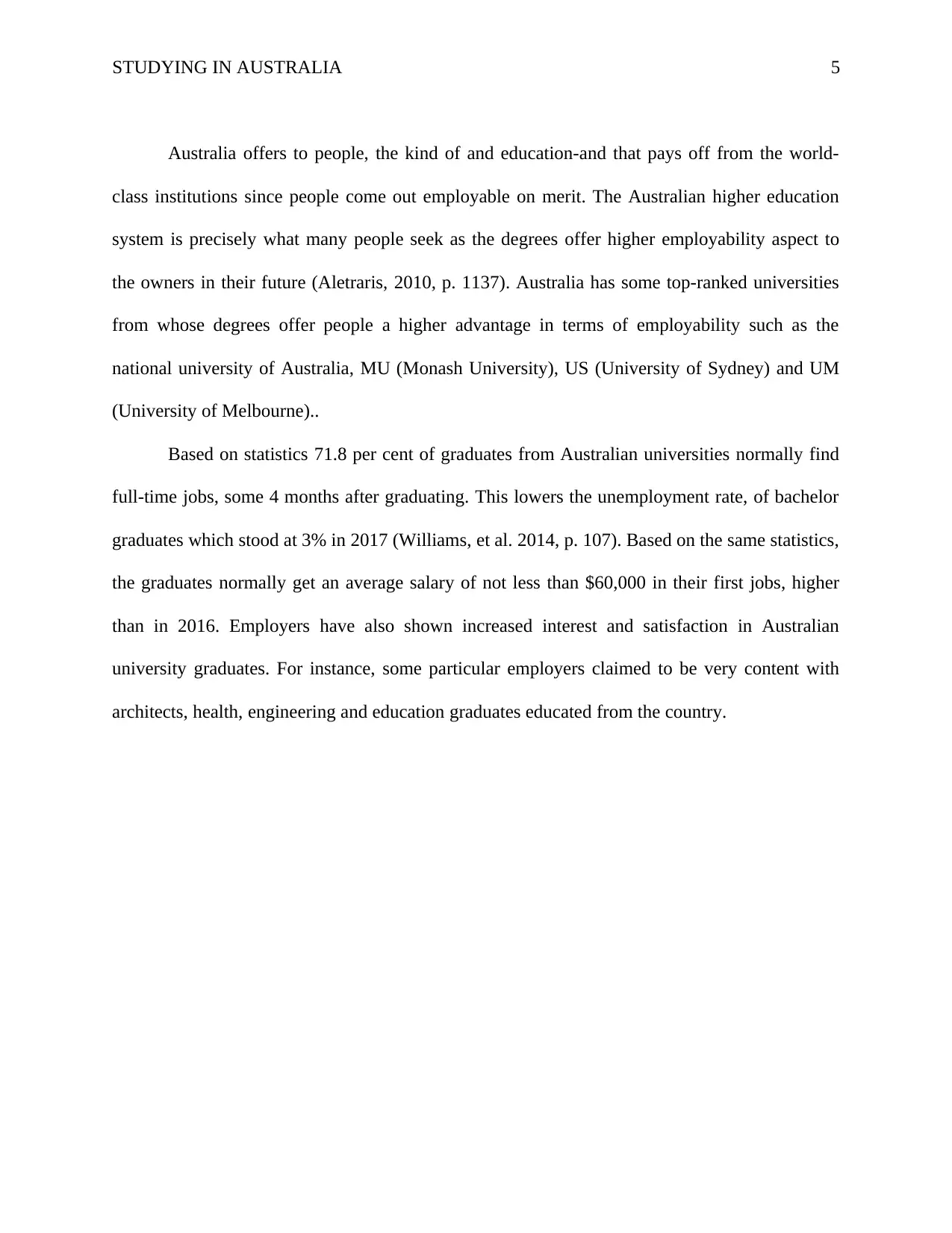
STUDYING IN AUSTRALIA 5
Australia offers to people, the kind of and education-and that pays off from the world-
class institutions since people come out employable on merit. The Australian higher education
system is precisely what many people seek as the degrees offer higher employability aspect to
the owners in their future (Aletraris, 2010, p. 1137). Australia has some top-ranked universities
from whose degrees offer people a higher advantage in terms of employability such as the
national university of Australia, MU (Monash University), US (University of Sydney) and UM
(University of Melbourne)..
Based on statistics 71.8 per cent of graduates from Australian universities normally find
full-time jobs, some 4 months after graduating. This lowers the unemployment rate, of bachelor
graduates which stood at 3% in 2017 (Williams, et al. 2014, p. 107). Based on the same statistics,
the graduates normally get an average salary of not less than $60,000 in their first jobs, higher
than in 2016. Employers have also shown increased interest and satisfaction in Australian
university graduates. For instance, some particular employers claimed to be very content with
architects, health, engineering and education graduates educated from the country.
Australia offers to people, the kind of and education-and that pays off from the world-
class institutions since people come out employable on merit. The Australian higher education
system is precisely what many people seek as the degrees offer higher employability aspect to
the owners in their future (Aletraris, 2010, p. 1137). Australia has some top-ranked universities
from whose degrees offer people a higher advantage in terms of employability such as the
national university of Australia, MU (Monash University), US (University of Sydney) and UM
(University of Melbourne)..
Based on statistics 71.8 per cent of graduates from Australian universities normally find
full-time jobs, some 4 months after graduating. This lowers the unemployment rate, of bachelor
graduates which stood at 3% in 2017 (Williams, et al. 2014, p. 107). Based on the same statistics,
the graduates normally get an average salary of not less than $60,000 in their first jobs, higher
than in 2016. Employers have also shown increased interest and satisfaction in Australian
university graduates. For instance, some particular employers claimed to be very content with
architects, health, engineering and education graduates educated from the country.
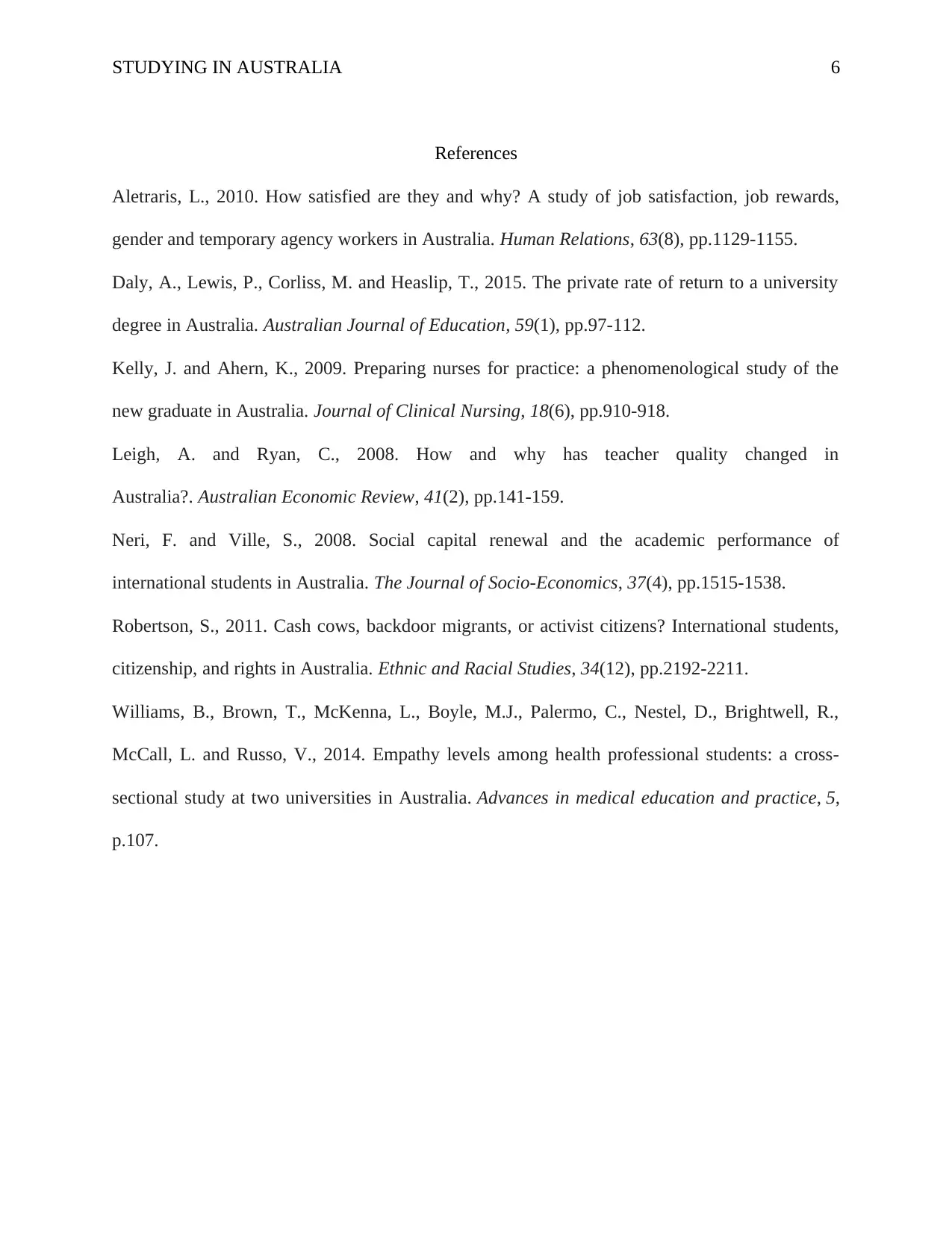
STUDYING IN AUSTRALIA 6
References
Aletraris, L., 2010. How satisfied are they and why? A study of job satisfaction, job rewards,
gender and temporary agency workers in Australia. Human Relations, 63(8), pp.1129-1155.
Daly, A., Lewis, P., Corliss, M. and Heaslip, T., 2015. The private rate of return to a university
degree in Australia. Australian Journal of Education, 59(1), pp.97-112.
Kelly, J. and Ahern, K., 2009. Preparing nurses for practice: a phenomenological study of the
new graduate in Australia. Journal of Clinical Nursing, 18(6), pp.910-918.
Leigh, A. and Ryan, C., 2008. How and why has teacher quality changed in
Australia?. Australian Economic Review, 41(2), pp.141-159.
Neri, F. and Ville, S., 2008. Social capital renewal and the academic performance of
international students in Australia. The Journal of Socio-Economics, 37(4), pp.1515-1538.
Robertson, S., 2011. Cash cows, backdoor migrants, or activist citizens? International students,
citizenship, and rights in Australia. Ethnic and Racial Studies, 34(12), pp.2192-2211.
Williams, B., Brown, T., McKenna, L., Boyle, M.J., Palermo, C., Nestel, D., Brightwell, R.,
McCall, L. and Russo, V., 2014. Empathy levels among health professional students: a cross-
sectional study at two universities in Australia. Advances in medical education and practice, 5,
p.107.
References
Aletraris, L., 2010. How satisfied are they and why? A study of job satisfaction, job rewards,
gender and temporary agency workers in Australia. Human Relations, 63(8), pp.1129-1155.
Daly, A., Lewis, P., Corliss, M. and Heaslip, T., 2015. The private rate of return to a university
degree in Australia. Australian Journal of Education, 59(1), pp.97-112.
Kelly, J. and Ahern, K., 2009. Preparing nurses for practice: a phenomenological study of the
new graduate in Australia. Journal of Clinical Nursing, 18(6), pp.910-918.
Leigh, A. and Ryan, C., 2008. How and why has teacher quality changed in
Australia?. Australian Economic Review, 41(2), pp.141-159.
Neri, F. and Ville, S., 2008. Social capital renewal and the academic performance of
international students in Australia. The Journal of Socio-Economics, 37(4), pp.1515-1538.
Robertson, S., 2011. Cash cows, backdoor migrants, or activist citizens? International students,
citizenship, and rights in Australia. Ethnic and Racial Studies, 34(12), pp.2192-2211.
Williams, B., Brown, T., McKenna, L., Boyle, M.J., Palermo, C., Nestel, D., Brightwell, R.,
McCall, L. and Russo, V., 2014. Empathy levels among health professional students: a cross-
sectional study at two universities in Australia. Advances in medical education and practice, 5,
p.107.
⊘ This is a preview!⊘
Do you want full access?
Subscribe today to unlock all pages.

Trusted by 1+ million students worldwide
1 out of 6
Related Documents
Your All-in-One AI-Powered Toolkit for Academic Success.
+13062052269
info@desklib.com
Available 24*7 on WhatsApp / Email
![[object Object]](/_next/static/media/star-bottom.7253800d.svg)
Unlock your academic potential
Copyright © 2020–2025 A2Z Services. All Rights Reserved. Developed and managed by ZUCOL.




